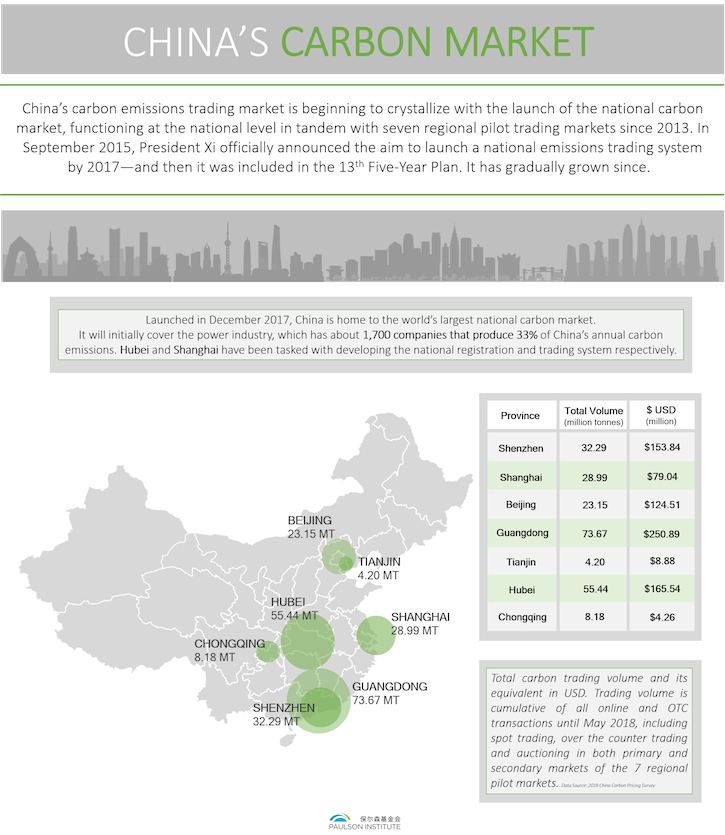Across China, local governments, businesses, and stakeholders have started to witness the humble beginnings of the national carbon market emissions trading scheme (ETS), which regulates carbon emissions through the allocation and transaction of permits. Officially announced in December 2017, the national ETS will only cover the power sector initially, while regional pilot markets have been operating in parallel in seven major cities since mid-2013: Beijing, Tianjin, Shanghai, Shenzhen, Chongqing, Hubei, and Guangdong.
Five years into the initiative, stakeholders are starting to get a sense of the strengths and shortfalls of the ETS, as well as solidifying predictions about the future of carbon pricing nationally. The Paulson Institute has developed a timeline to track the continued evolution of China’s carbon market by providing a quick snapshot of important carbon market developments and carbon financing innovations.
China has a number of challenges ahead in establishing a full-blown and fully-operational carbon trading system. The government plans to address them over the next few years, but a key priority for the newly established Ministry of Ecology and Environment (MEE) is the improvement of the regulatory and administrative framework for the national carbon market.
Perhaps one of the biggest carbon trade developments of 2018 has been the implementation of the measurement, reporting, and verification (MRV) system, in which all local governments were required to report and verify historical data covering key sectors across the country. A robust MRV system is a key and fundamental component for an effective China ETS to monitor carbon emissions and translate granular detail of the carbon trade for more accurate allowance allocations. With these and other lessons learned, and ongoing real-time experiences from the regional pilots, the formation of a sustainable national MRV system remains one of the top priorities for the national carbon market and the topic of the Paulson Institute’s latest policy brief.
In late June, the Central Committee of the Communist Party of China (CPC) and the State Council issued Guidelines on ecological environment reaffirming the development of a robust carbon market in China as a priority. The State Council issued a Notice on in August announcing the reshuffle of the Leading Group dealing with climate change. Premier Li Keqiang will head the Leading Group and be supported by Vice Premier Han Zheng and State Councilor Wang Yi as deputy leaders. The MEE and the National Development and Reform Commission (NDRC) will implement the Leading Group’s directives.
In early September, the MEE organized a national carbon market work conference, in which the power generation industry participated in an implementation meeting for national carbon market trading. This served as a positive policy signal for continued progress of the national carbon market. Zhuang Guotai, Vice Minister of the MEE, said at the meeting, “the power industry will be the first to conduct transactions across the country, gradually expanding the scope of the industry and the transactions, and increasing products traded and market activity.” He further stated that carbon market development would “prevent over financialization and financial risks” and “strengthen the capacity building for carbon market development at the provincial level MEE departments.” The conference certainly mobilized various local MEE and NDRC departments, state-run enterprises, electric, power and other industry associations to play an active role in promoting the development of the national carbon market.
With actual trading slated to begin around 2020, the next two years will be crucial. The MEE plans to create market infrastructure, build capacity, and host an extended period of trading simulation. China still has a long way to go to develop its national carbon market and extend it beyond the power industry. It will require the cooperation of relevant authorities, local governments, industry associations, enterprises, and international organizations and institutions to promote an effective national carbon market. China’s national carbon market will provide valuable experiences and lessons for the global response to climate change and the development of global carbon markets.



